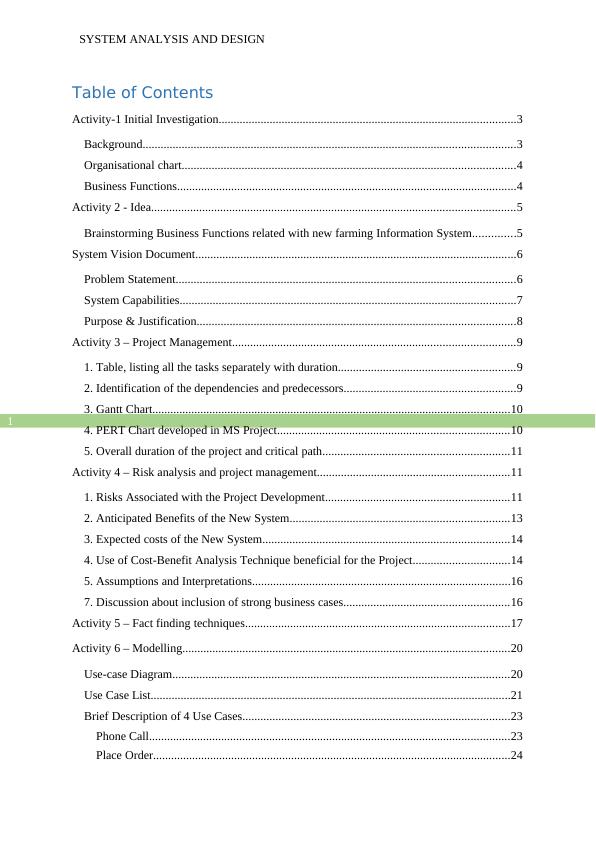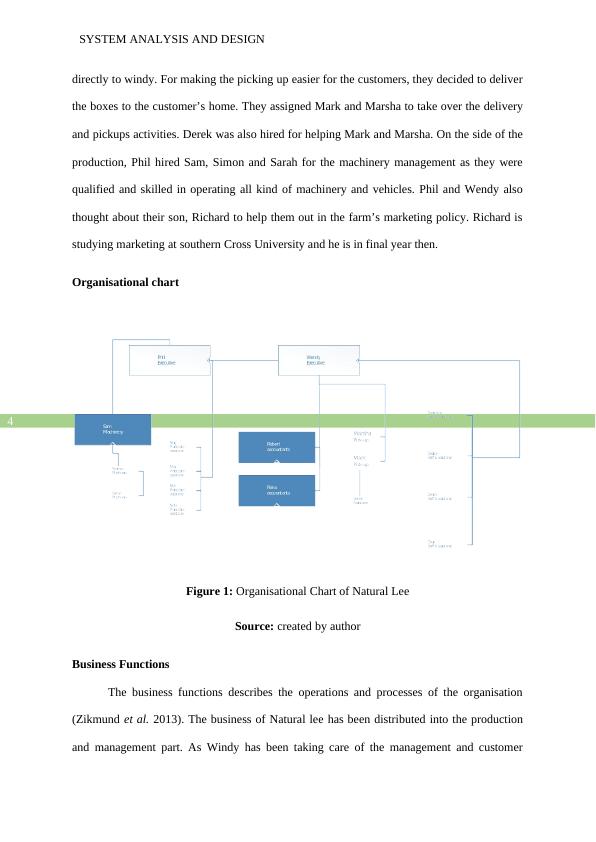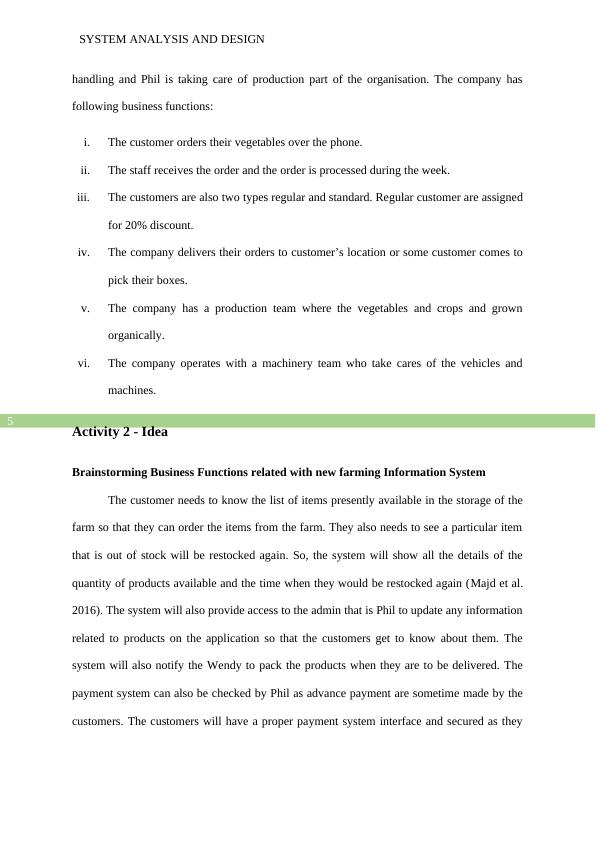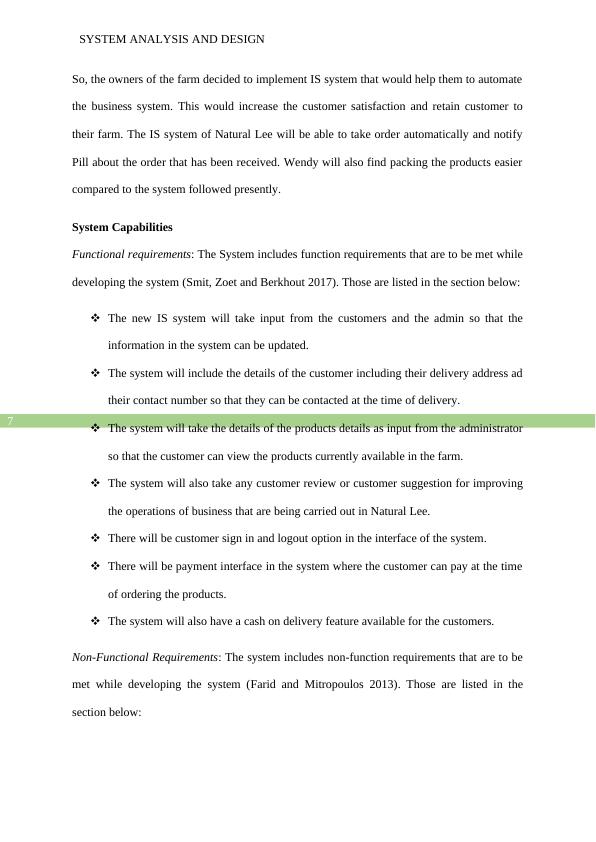Design Name of the University Author
This case study is about Natural-Lee, a business that produces organically certified vegetables, fruit and nuts, honey, decorative plants, and eggs using permaculture principles and biodynamic soils. The case study will be used to answer questions in set activities throughout the semester and will be compiled into a report. Part A of the report, an 'Initial Investigation,' is due at the end of Week 6, and the final report is due in Week 12.
Added on 2022-10-17
About This Document
Design Name of the University Author
This case study is about Natural-Lee, a business that produces organically certified vegetables, fruit and nuts, honey, decorative plants, and eggs using permaculture principles and biodynamic soils. The case study will be used to answer questions in set activities throughout the semester and will be compiled into a report. Part A of the report, an 'Initial Investigation,' is due at the end of Week 6, and the final report is due in Week 12.
Added on 2022-10-17
System Analysis and Design
Name of the student
Name of the University
Author Note

1
Table of Contents
Activity-1 Initial Investigation...................................................................................................3
Background............................................................................................................................3
Organisational chart...............................................................................................................4
Business Functions.................................................................................................................4
Activity 2 - Idea.........................................................................................................................5
Brainstorming Business Functions related with new farming Information System..............5
System Vision Document...........................................................................................................6
Problem Statement.................................................................................................................6
System Capabilities................................................................................................................7
Purpose & Justification..........................................................................................................8
Activity 3 – Project Management..............................................................................................9
1. Table, listing all the tasks separately with duration...........................................................9
2. Identification of the dependencies and predecessors.........................................................9
3. Gantt Chart.......................................................................................................................10
4. PERT Chart developed in MS Project.............................................................................10
5. Overall duration of the project and critical path..............................................................11
Activity 4 – Risk analysis and project management................................................................11
1. Risks Associated with the Project Development.............................................................11
2. Anticipated Benefits of the New System.........................................................................13
3. Expected costs of the New System..................................................................................14
4. Use of Cost-Benefit Analysis Technique beneficial for the Project................................14
5. Assumptions and Interpretations......................................................................................16
7. Discussion about inclusion of strong business cases.......................................................16
Activity 5 – Fact finding techniques........................................................................................17
Activity 6 – Modelling.............................................................................................................20
Use-case Diagram................................................................................................................20
Use Case List........................................................................................................................21
Brief Description of 4 Use Cases.........................................................................................23
Phone Call........................................................................................................................23
Place Order.......................................................................................................................24

2
Deposit.............................................................................................................................25
Delivery............................................................................................................................25
Activity Diagram..................................................................................................................26
Activity 7 – Fact Findings and Data Description.....................................................................27
Fact finding..........................................................................................................................27
ERD – conceptual................................................................................................................28
ERD- Physical......................................................................................................................30
Code format and Sample data..............................................................................................31
Customer..........................................................................................................................31
Order................................................................................................................................31
Payment............................................................................................................................31
Vegetables........................................................................................................................31
Farms................................................................................................................................32
Bank.................................................................................................................................32
Activity 8 – Suitable software and Feasibility.........................................................................32
Sequence Diagram...............................................................................................................32
Commercial Software...........................................................................................................33
Comparison......................................................................................................................33
Options of implementation...............................................................................................34
Conclusion................................................................................................................................34
Feasibility Analysis and Recommendations........................................................................35
References................................................................................................................................36
Appendices...............................................................................................................................41
Activity 1 - Organizational chart..........................................................................................41
Activity 3 – Gantt and Pert chart..........................................................................................42
Activity 5 – Questions..........................................................................................................44
Activity 6 – use case and activity diagram...........................................................................44
Activity 7 – System design..................................................................................................46
Activity 8 – Sequence diagram............................................................................................48

3
Activity-1 Initial Investigation
Background
Phil lee has a passion for growing and carrying forward his father’s and grandfather’s
legacy for living sustainably and green. He has some cattle and sheep for producing egg, milk
and manure. Using the manure he used it as fertilizers and practiced companion planting for
saving the crops from the insect attacks. He also used the method of alternate cultivation to
keep the soil healthy. Formally, Phil was a carpenter and he left his occupation and followed
his dreams by growing and providing high quality food. His buyers comes to him for the
purchasing or picking their order. Orders are generally made through phone. The order lists
are written and processed manually. Phil is a talkative person and he loves to talk with his
customer on phones. However, the daily customers who have same order every week, had
frustration that Phil takes so long time for writing up the orders and after that processing and
delivering is involved. The pickup procedure was done by mainly the customers who picks
their weekly boxes of ordered vegetables. The farm got famous around the neighbourhood
and more customers were coming. At the end, it was getting difficult to handle that amount of
customers. He used to store the customer details by pen and paper so that customer could ring
and remind the order and he can recognise with the details he recorded. Windy is her wife
and she is fully supportive to Phil. She introduced the idea that they will focus on the
different aspects of their business. The new system will help a lot Phil to manage his growing
customers and demands. Phil was more concentrated on the production part and windy was
supposed to handle management and customer handling. Windy assigned Doug, Debbie,
Dongming and Dennis for taking orders from the customer. They also assisted in other
activities sometimes. They also included the idea of giving discount of 20% to the regular
customers. Rena and Robert was assigned as accountant in the organisation and they reported

4
directly to windy. For making the picking up easier for the customers, they decided to deliver
the boxes to the customer’s home. They assigned Mark and Marsha to take over the delivery
and pickups activities. Derek was also hired for helping Mark and Marsha. On the side of the
production, Phil hired Sam, Simon and Sarah for the machinery management as they were
qualified and skilled in operating all kind of machinery and vehicles. Phil and Wendy also
thought about their son, Richard to help them out in the farm’s marketing policy. Richard is
studying marketing at southern Cross University and he is in final year then.
Organisational chart
Figure 1: Organisational Chart of Natural Lee
Source: created by author
Business Functions
The business functions describes the operations and processes of the organisation
(Zikmund et al. 2013). The business of Natural lee has been distributed into the production
and management part. As Windy has been taking care of the management and customer

5
handling and Phil is taking care of production part of the organisation. The company has
following business functions:
i. The customer orders their vegetables over the phone.
ii. The staff receives the order and the order is processed during the week.
iii. The customers are also two types regular and standard. Regular customer are assigned
for 20% discount.
iv. The company delivers their orders to customer’s location or some customer comes to
pick their boxes.
v. The company has a production team where the vegetables and crops and grown
organically.
vi. The company operates with a machinery team who take cares of the vehicles and
machines.
Activity 2 - Idea
Brainstorming Business Functions related with new farming Information System
The customer needs to know the list of items presently available in the storage of the
farm so that they can order the items from the farm. They also needs to see a particular item
that is out of stock will be restocked again. So, the system will show all the details of the
quantity of products available and the time when they would be restocked again (Majd et al.
2016). The system will also provide access to the admin that is Phil to update any information
related to products on the application so that the customers get to know about them. The
system will also notify the Wendy to pack the products when they are to be delivered. The
payment system can also be checked by Phil as advance payment are sometime made by the
customers. The customers will have a proper payment system interface and secured as they

6
will pay by entering their card details to the farm. After payment, the system will generate
automatic invoice for the customer to be delivered along with the products ordered.
The system will also include logistics management that would arrange all the orders
according to the ordered placed by the customers. The system will also show online
documentation of the organize products that are grown by Natural Lee and would show the
government certification along with all terms and conditions that they follow to run this
business (Koester 2016). This would gain customer trust that the products are genuine and
original organic products. The system will also have a feature to take customer suggestion of
any complaints that they have against Natural Lee. The customer are also shown the contact
details of Phil and Wendy so that they can call in case of any query. The system will also
notify the customer when the delivery agent is allocated to place the order and the time they
will get the products in hand.
System Vision Document
Problem Statement
Phil and Wendy being the owner of Natural Lee was handling the operations of the
business manually because they were not having any automated system of handling the
process. Phil was handling the customer ordering process and Wendy was responsible to
dispatch the ordered products. But as the system was growing, they were facing difficulty in
handling the operations of the business and were losing customer because they were not able
to provide customer with proper information about products (Griffin 2018). They were also
not able to deliver the products on time. Moreover, Natural Lee also grew tasteful fruits
which were not in the selling items lists presently. Both of them decided to include the selling
of fruits as well to the customer. As a result the business handling manually was to become
more difficult with vast list of products to sell.

7
So, the owners of the farm decided to implement IS system that would help them to automate
the business system. This would increase the customer satisfaction and retain customer to
their farm. The IS system of Natural Lee will be able to take order automatically and notify
Pill about the order that has been received. Wendy will also find packing the products easier
compared to the system followed presently.
System Capabilities
Functional requirements: The System includes function requirements that are to be met while
developing the system (Smit, Zoet and Berkhout 2017). Those are listed in the section below:
The new IS system will take input from the customers and the admin so that the
information in the system can be updated.
The system will include the details of the customer including their delivery address ad
their contact number so that they can be contacted at the time of delivery.
The system will take the details of the products details as input from the administrator
so that the customer can view the products currently available in the farm.
The system will also take any customer review or customer suggestion for improving
the operations of business that are being carried out in Natural Lee.
There will be customer sign in and logout option in the interface of the system.
There will be payment interface in the system where the customer can pay at the time
of ordering the products.
The system will also have a cash on delivery feature available for the customers.
Non-Functional Requirements: The system includes non-function requirements that are to be
met while developing the system (Farid and Mitropoulos 2013). Those are listed in the
section below:

End of preview
Want to access all the pages? Upload your documents or become a member.
